The YC61 Organ Section features all new Virtual Circuitry Modeling (VCM), Frequency Modulation (FM) Organs and Rotary Speaker Effects. It is is the heart of the YC61 Stage Keyboard with a new VCM Organ engine, new VCM Rotary Speaker effect, new physical drawbar design with an 8-segment backlit LED with 7 color options. Check it out up close below:
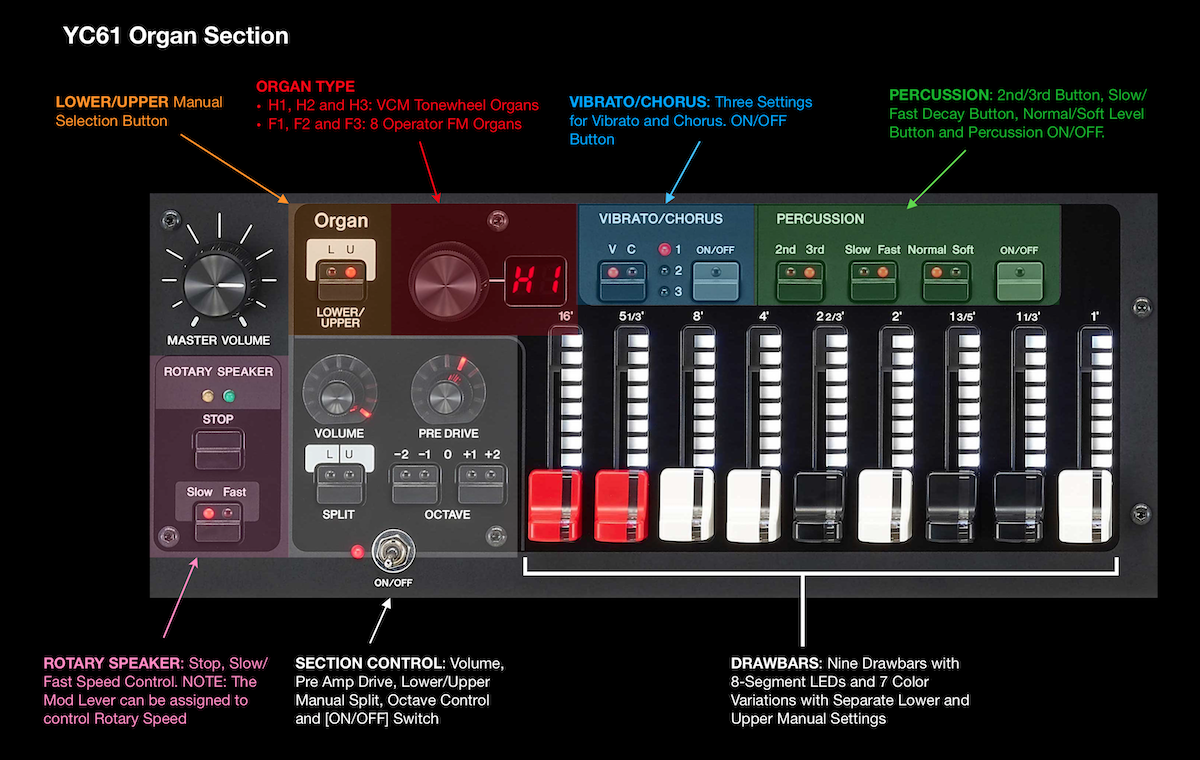
The Organ Section is nicely laid out in on left side of the instrument. Each organ component – Percussion, Vibrato/Chorus and Rotary Speaker Control – is right there with dedicated buttons, but the drawbar controls are something special. They feel great, have a slight click at each of the eight segments and have appropriate coloring and footage (two Red at 16’ and 5 1/3’, two White at 8’ and 4’, one Black at 2 2/3’, one White at 2’, two Black at 1 3/5’ and 1 1/3’ and one White at 1’). But check out the translucent strip on each of the drawbars. This is a cool design allowing you to see the drawbar LED settings when changing between Live Set Sounds or Upper/Lower Manual Settings. Check it out:
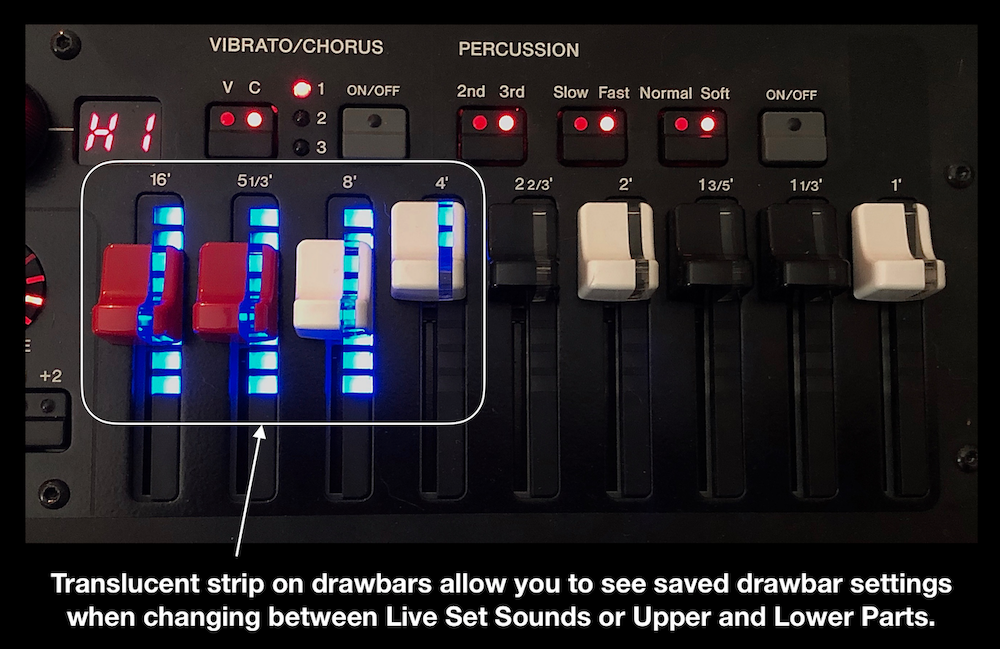
And speaking of drawbar LED settings, you have a choice of seven different color variations with independent settings for Upper and Lower Manuals:
Organ drawbars engage different harmonics when pulled out. There are eight segments for each drawbar. Pulling them down increases the level of the associated harmonic. The 16’, 8’, 4’, 2’ and 1’ all sound the fundamental at different octaves. The other drawbars are either sound as follows:
- The 5 1/3’ drawbar sounds a fifth above the 8’ drawbar.
- The 2 2/3’ sounds a fifth above the 4’,
- The 1 3/5 sounds a major third above the 2’
- The 1 1/3’ sounds a fifth above the 2’
Check out the graphic below:
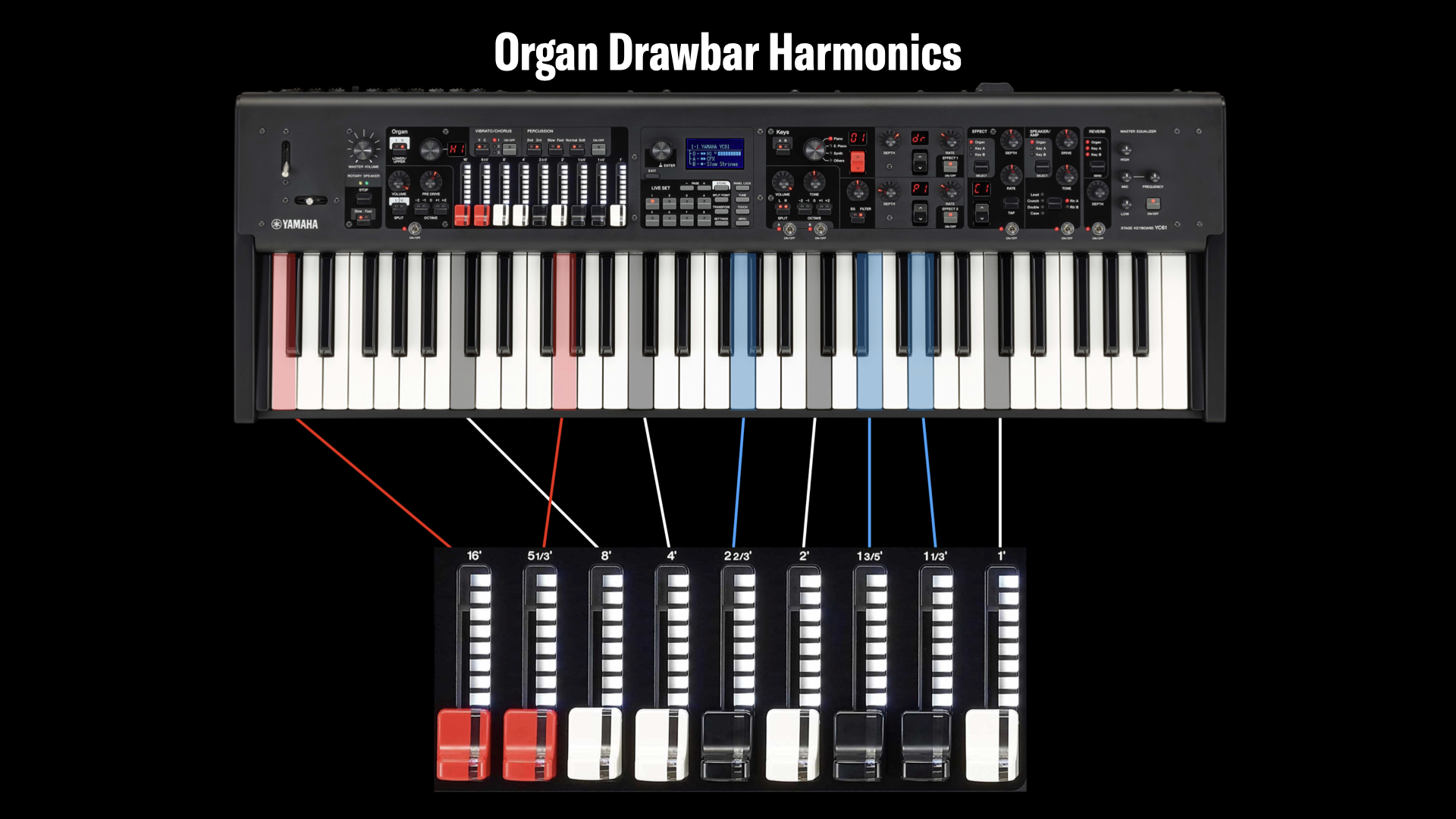
In essence, the drawbar organ can be thought of as the first additive synthesizer! The magic of drawbar organs is found in the different combinations. From jazz leads, background comping to moody pads, drawbar settings can cover a huge range of musical genre.
H Organ Types
The “H” type organs feature brand new VCM technology (Virtual Circuitry Modeling) cover the traditional drawbar organ sound and each one has a different harmonic character. The three basic H types are:
- H1: I call this the “mint condition” version. It has a full pure sound and is great for just about anything. When the organ is the main instrument, especially in a jazz trio, H1 is the perfect choice.
- H2: This type has more emphasis in the mid- to low-range frequencies and has a bit of leakage (sound “leaked” from one pickup to another resulting in added harmonics). This is a great choice when the organ is part of a band. It’s great for chord comping and really fills out the sound of the ensemble nicely so I find it ideal for gospel and R&B.
- H3: This type has a unique percussion sound and interesting high frequency leakage, making the ideal rock organ. It has a massive sound when you apply drive and is suitable for hard rock of the 60s, 70s, 80s and beyond.
I think of these as starting points because important components of the sound like key click and leakage can be adjusted. You can really customize the sound and get it just the way you want. This is brand new for the YC61 and deserves a closer look. The VCM Organs, the VCM Rotary Speaker Types and how this system works together to deliver an authentic, soulful and expressive experience. The description in the manual is quite good:
“The VCM Organ tone generator was developed to faithfully reproduce the sound of a tonewheel-type vintage organ.
VCM stands for “Virtual Circuitry Modeling™,” and is technology that uses DSP to emulate the functions of an analog electric circuit. This technology enables the instrument to reproduce sound with an analog-like depth, which cannot be reproduced by a simple digital sound.
By applying this technology, the VCM Organ tone generator fully reproduces the following characteristics of a vintage organ:
– Natural, organic harmonies when playing chords—thanks to a matrix circuit that connects the keyboard, tonewheels, and drawbars
– Percussion sound with remarkable presence—based on vacuum tube circuit analysis
– Key clicks and leakage sounds—based on electrical circuit analysis
– Natural sound distortion—simulating vintage vacuum tube pre-amplifiers
– Vibrato/Chorus effect—from scanner-based vibrato circuitry
– Changes in frequency characteristics and drive amount that responds dynamically to operation of the expression pedal
Adjustment of these detailed parameters makes it possible to accurately recreate the distinctive characteristics of the original instruments—including all of their specially attractive imperfections, faults and even deterioration.”
The “distinctive characteristics” VCM reproduces are warmth and authentic character. The things that stand out to me when playing these organ types:
There is a wonderful low/low-mid/midrange emphasis coupled with a de-emphasis on high frequencies with the H Type organs. That frequency spectrum is an important aspect of the tonewheel organ sound
The fourth point above about natural sound distortion is significant to the overall sound. The SPEAKER/AMP Section on YC61 is great. These effects produce an ultra-warm, full and enveloping sound and the DRIVE and TONE knobs offer easy access to satisfying results. I’ll explore Rotary Speaker effects in more detail below.
The last point about changes in frequency characteristics and drive amount that respond to the expression pedal is especially significant. For example, when you play a “hit” chord synchronized with a sudden expression volume swell how the sound responds is important. With the YC61 the expression pedal applies to both volume and preamp level, so volume changes couple with changes in preamp drive making swells deeply expressive and full.
NOTE: What to know more about the history of vintage drawbar organs? Go here. And for those who don’t know about Thaddeus Cahill and the Telharmonium, the first instrument using this electromechanical technology, go here! Not only was the Telharmonium cool, it was the first music streaming service!
H Type Organ Examples:
Check a few examples of the H Type Organs below. The first example features H1 with Rotary A:
The second example is H2 also with Rotary A. Notice the breathiness of the increased leakage. There is a warmth and soulfulness in this sound:
The example below is H3 with Rotary Speaker B. With the added drive supplied by Rotary B, H3 is a great choice for hard rock, progressive rock and southern rock. Rock on!
New F Organ Types
FM Synthesis is capable of producing great organ tones. I remember processing my DX7 with a rotary speaker stomp box and got a great organ sound back in the day (Algorithm 32 works great)! The H Organ Types certainly sound amazing, but the 8-Operator F Organ Types are unique to the YC61 and afford a wider range of sound and artistic exploration. Each type focuses on a particular sound:
- F1: Each of the eight Operators generate sine waves set at the footages of the first eight drawbars. F1 Type has a pure sound with lots of low end because it lacks the foldback characteristics of the tonewheel organ. This organ sounds amazing is often my choice for soulful ballads and organ pads, and gospel organists will love the enveloping bass response.
- F2: This organ type generates the square, pulse type waveform. This can generate sounds like British transistor combo organ.
- F3: With its brighter, sawtooth type waveform, the F3 Organ Type is a good way to get the sound of Italian transistor combo organs.
I find the F Organ Types useful as textural pads, especially when used with the on-board effects. By default, sustain pedal control is off in the Organ Section. You can turn it on in the SETTINGS. You can create great layered sounds when combined with Voices from the Keys Section.
Check out the F Organ Types below. The first example uses the F1 and it’s one of my favorites. It has a great soulful quality when combined with the VCM Rotary Speaker:
The F2 Organ Type is all about that British transistor organ sound popular on lots of hits of the 60s and 70s. When combined with the on-board effects lots of creative possibilities emerge:
I am a big fan of Italian movies and the F3 Organ Type is the perfect sound. Based on the Italian transistor organ sound it has the ability to cut through a mix especially when used with the distortion in the SPEAKER/AMP section of the YC61:
New VCM Rotary Speaker
The Organ Section is only part of the picture: The new VCM Rotary Speaker effects in the SPEAKER/AMP section add a crucial finishing touch to the sound. YC61 introduces two new types:
• Rtr A: This is a standard Rotary Speaker effect and the ideal choice for jazz, R&B and gospel.
• Rtr B: Rotary Speakers can be connected to things like transistor preamps for more drive and distortion. Rtr B simulates this set up and is great for rock, jazz fusion and funk.
Both Rotary Speaker types are incredibly accurate recreations. The dedicated DRIVE and TONE knobs allow simple and effective tweaks to the sound:
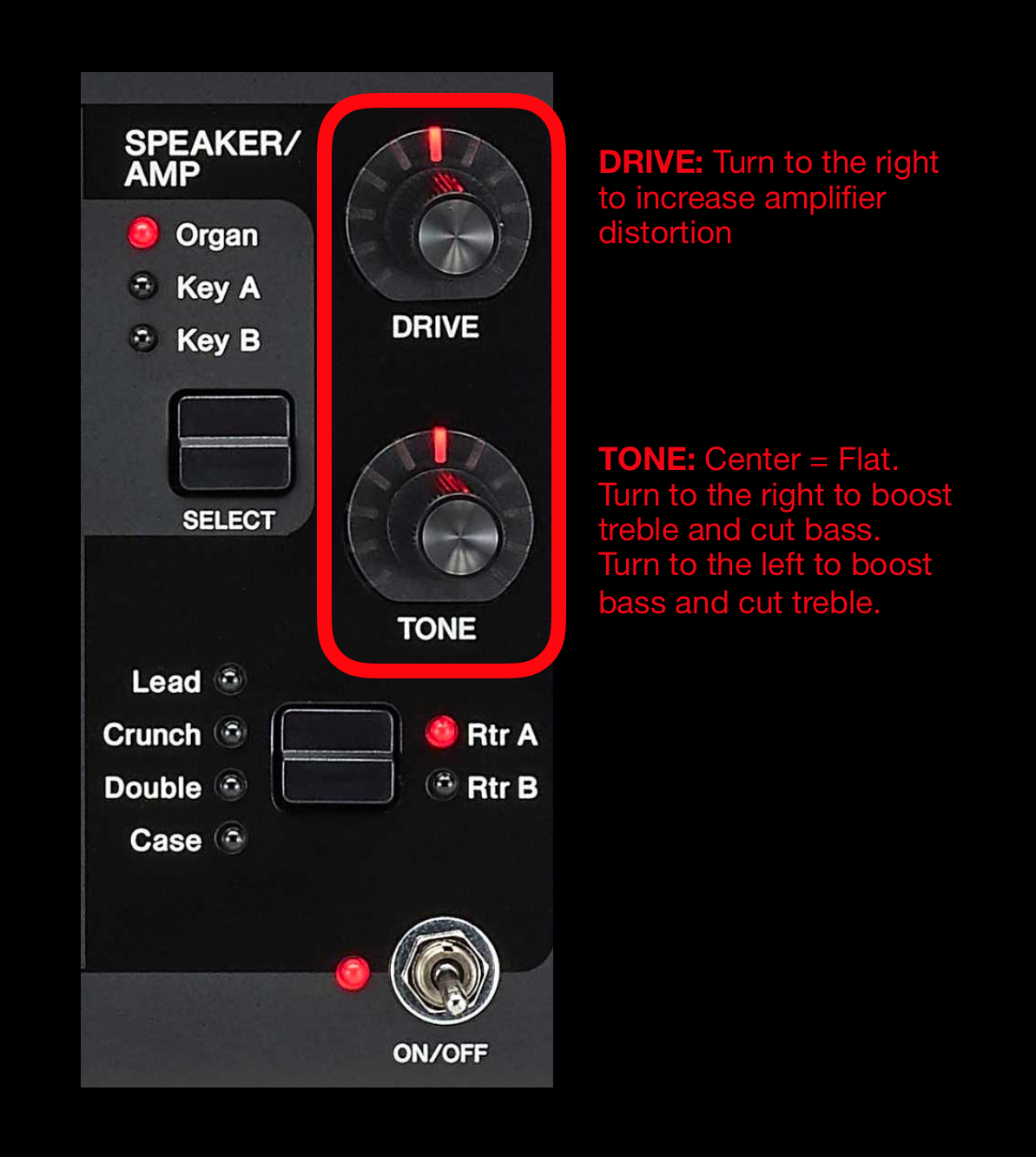
Need a dark sound with a bit of drive in a jazz trio? Select “Rtr A” increase DRIVE and decrease TONE. Looking to cut through on a hard rock song for a blistering solo? Select “Rtr B” increase both DRIVE and TONE. You have simple and effective ways to adjust your sound.
Organ Customization
The VCM Organ and Rotary Speaker system have simple yet powerful customization options. During our artist evaluations questions came up like:
- Can I adjust the amount of leakage? I love that sound in certain songs.
- I like to control key click. Is that doable?
- I like tweaking the rotary speaker effect, especially the speed. What options do I have?
The customization options are great and make it simple to dial in your sound. It’s awesome! The settings adjustments below allow you to customize organ/rotary speaker sound and idiosyncrasies:
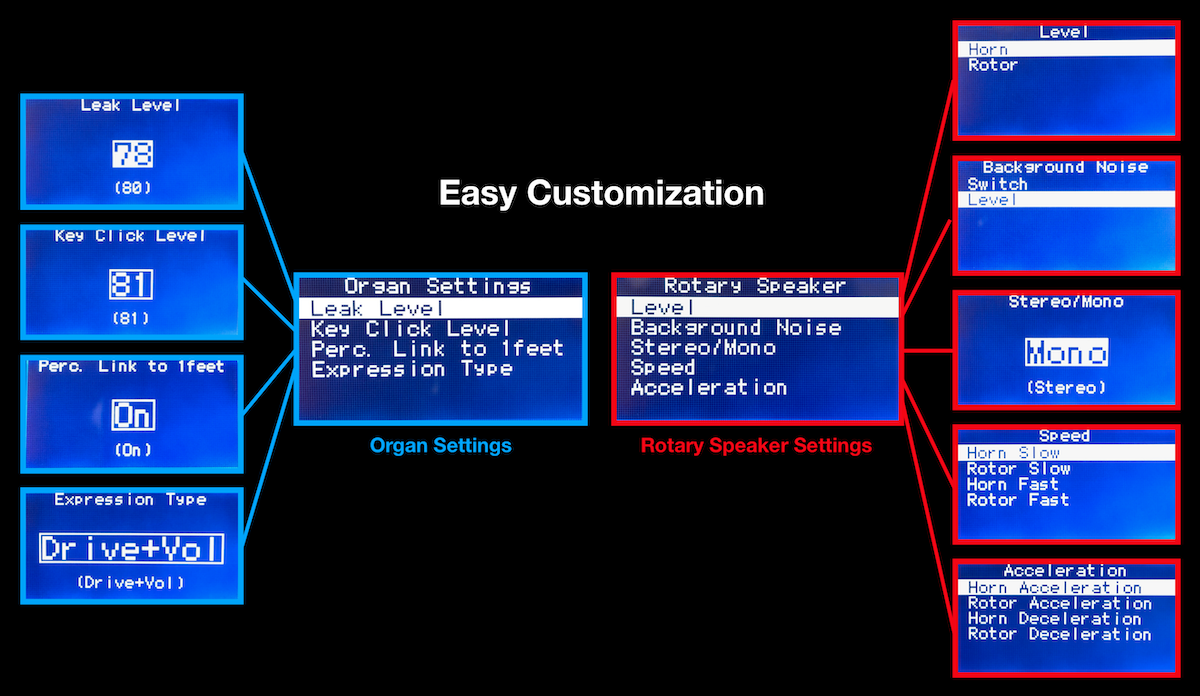
A few tips:
- Increasing Leak Level and Key Click: These settings add a “played in” feel to the sound. Adjusting Leak Level adds interesting harmonics to the overall sound and is great for background accompaniment. Key click can add a nice percussive quality each time a key is pressed. It’s useful in solo and lead playing.
- Perc. Link to 1feet: This is a cool setting that traditionally isn’t available on vintage drawbar organs because the 9th drawbar is also responsible for organ percussion. That “either/or” situation is eliminated with this setting by turning it ON. This allows you to have organ percussion and the high frequency “whistle” sound that comes from the 9th drawbar when set to “Off”.
- Expression Type: This is a nice setting that links preamp drive and volume to the expression pedal. When set to “Drive+Vol” both are increased making swells that much more musical and powerful.
- Adjustments to Horn and Rotor Levels: The Horn level accentuates higher frequencies and Rotor level accentuates lower frequencies. Adjustments to these parameters can help you get the sound you want, from bright and forceful to dark and enveloping.
- Background Noise: Increasing this parameter adds a cool authenticity to the rotary speaker sound. Check it out:
The audio example below illustrates the different results of organ customization. Each example below uses the same setting with the first 3 drawbars pulled all the way down and the 4th drawbar set at 3 (888300000). The musical example is the same, but I made changes to leakage, key click, preamp drive and rotary speaker settings. Check it out:
New Waterfall Keyboard
With the new Organ and Rotary Speaker Types comes an all new semi-weighted waterfall keyboard. Unlike piano style keys, with have key tops extending over the key body, the waterfall keyboard is completely smooth:
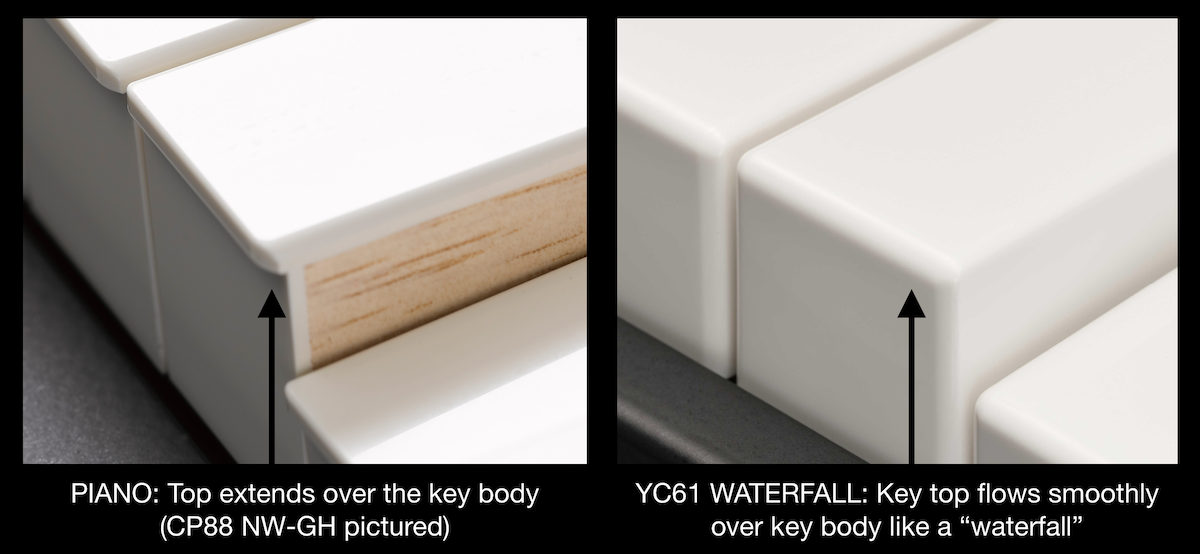
I’ve been spending a lot of time playing the YC61 and really enjoy playing the waterfall keyboard. It’s interesting: Organ techniques developed around waterfall keys and make articulations like palm smears, squabble-style playing and glissando feel natural. For this reason, organists will feel right at home playing the YC61.
Coming from a piano background I found it easy it was to adjust to the feel. It absolutely makes playing organ easier, but I enjoy playing acoustic and electric pianos, synth leads, pads, strings, brass sections, etc., from the YC61. It is different than a weighted action no doubt, but the YC61 has a bit of weight behind it, is touch responsive and you have a set of velocity curves to tailor the action to the sound. Ultimately, I foresee it as perfect top keyboard to something like CP88, MONTAGE or MODX, but I’d be comfortable doing an entire gig with YC61.
Stay tuned for an overview of the Keys Section!
Want to share your thoughts/comments? Join the conversation on the Forum here.
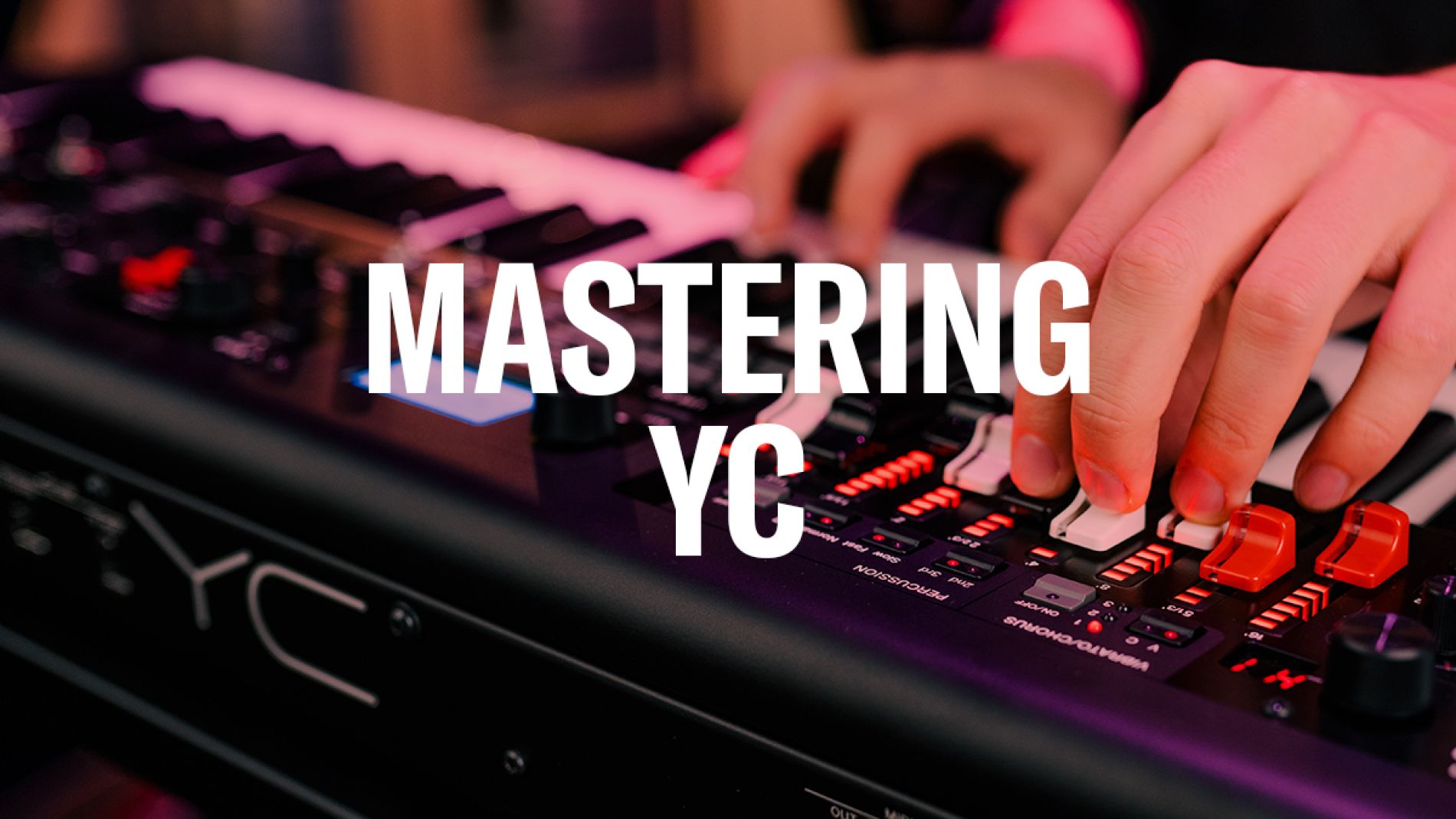
 The Organ Section is nicely laid out in on left side of the instrument. Each organ component – Percussion, Vibrato/Chorus and Rotary Speaker Control – is right there with dedicated buttons, but the drawbar controls are something special. They feel great, have a slight click at each of the eight segments and have appropriate coloring and footage (two Red at 16’ and 5 1/3’, two White at 8’ and 4’, one Black at 2 2/3’, one White at 2’, two Black at 1 3/5’ and 1 1/3’ and one White at 1’). But check out the translucent strip on each of the drawbars. This is a cool design allowing you to see the drawbar LED settings when changing between Live Set Sounds or Upper/Lower Manual Settings. Check it out:
The Organ Section is nicely laid out in on left side of the instrument. Each organ component – Percussion, Vibrato/Chorus and Rotary Speaker Control – is right there with dedicated buttons, but the drawbar controls are something special. They feel great, have a slight click at each of the eight segments and have appropriate coloring and footage (two Red at 16’ and 5 1/3’, two White at 8’ and 4’, one Black at 2 2/3’, one White at 2’, two Black at 1 3/5’ and 1 1/3’ and one White at 1’). But check out the translucent strip on each of the drawbars. This is a cool design allowing you to see the drawbar LED settings when changing between Live Set Sounds or Upper/Lower Manual Settings. Check it out:

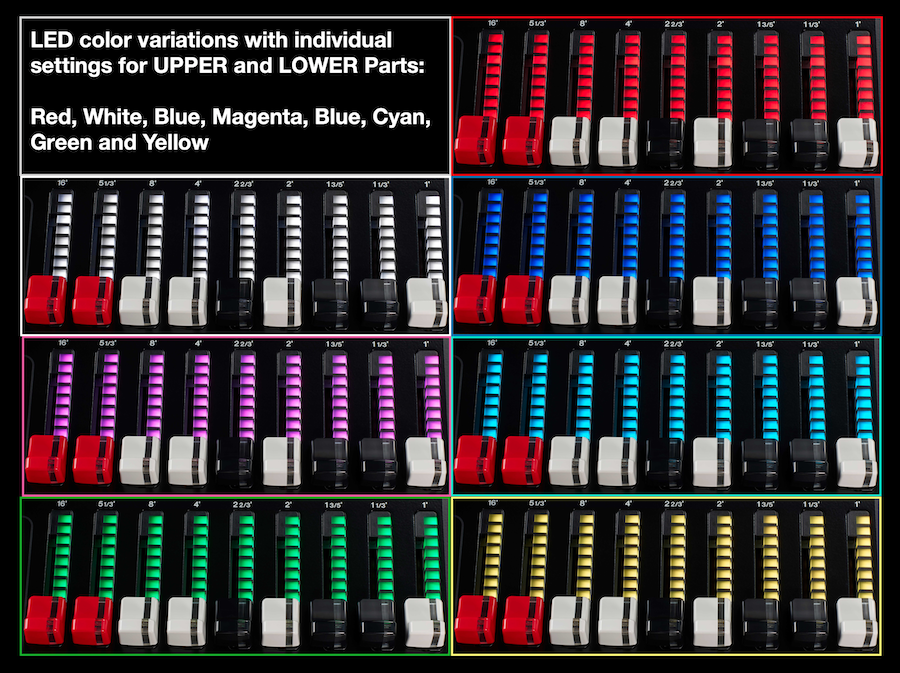
 In essence, the drawbar organ can be thought of as the first additive synthesizer! The magic of drawbar organs is found in the different combinations. From jazz leads, background comping to moody pads, drawbar settings can cover a huge range of musical genre.
In essence, the drawbar organ can be thought of as the first additive synthesizer! The magic of drawbar organs is found in the different combinations. From jazz leads, background comping to moody pads, drawbar settings can cover a huge range of musical genre.


